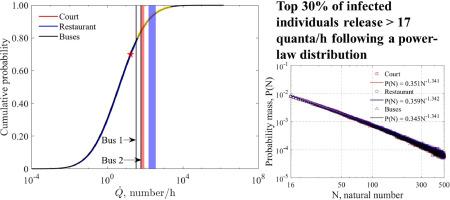A power-law distribution of infectious quanta for the top 30% of SARS-CoV-2-infected individuals
IF 7.6
1区 工程技术
Q1 CONSTRUCTION & BUILDING TECHNOLOGY
引用次数: 0
Abstract
Minimising airborne infection with respiratory viruses, such as SARS-CoV-2, requires knowledge of the infectious quanta generation rate for determining the minimum dilution requirement. The two existing methods for estimating quanta generation rates are the viral load method and outbreak method. The former method is challenged by significant uncertainty in input data, including dose-response parameters and infectious viral loads. The latter method, based on the Wells–Riley equation, is challenged by significant individual heterogeneity in quanta generation rates and lack of outbreak data. In this study, the two methods are integrated for studying the quanta generation profile of all individuals infected with an ancestral SARS-CoV-2 strain, based on four reported outbreaks of infection. The airborne transmission droplet size ranges in the four outbreaks, which were determined in previous studies, are used to estimate the hourly volume of expired droplets for the viral load method. Various viral load datasets and conversion factors from RNA copies to infectious quanta are tested. Two criteria are used to identify the probable quanta generation profile, i.e. 70% of infected individuals do not infect others, and the estimated quanta generation rates estimated using the outbreak method should be within the top 80%–99% of infected individuals. The predicted quanta generation profile of all individuals infected with SARS-CoV-2 follows a log-normal distribution, whereas that of the top 30% of infected individuals approximately follows a power-law distribution.
Practical significance: A major obstacle in defining dilution requirements for minimising airborne infection is the lack of infectious quanta generation rates for the general population. Our approach integrates two existing quanta estimation methods and paves the way to obtaining reliable quanta generation rate profiles at the population level.

最高 30% 的 SARS-CoV-2 感染者的感染量子呈幂律分布
要尽量减少呼吸道病毒(如 SARS-CoV-2 病毒)在空气中的感染,就必须了解感染量子的产生率,以确定最低稀释要求。现有的两种估算量子产生率的方法是病毒载量法和疫情爆发法。前一种方法受到输入数据(包括剂量-反应参数和传染性病毒载量)的巨大不确定性的挑战。后一种方法基于威尔斯-瑞利方程,但由于量子生成率存在显著的个体异质性和缺乏疫情数据而面临挑战。在本研究中,根据四次疫情报告,将这两种方法结合起来,研究了所有感染 SARS-CoV-2 祖毒株的个体的量子生成情况。以前的研究确定了四次爆发中的空气传播飞沫大小范围,在病毒载量法中,这些范围被用来估算每小时排出的飞沫量。对各种病毒载量数据集以及从 RNA 拷贝到感染量子的转换系数进行了测试。有两个标准可用于确定可能的量子产生情况,即 70% 的感染者不会感染他人,使用爆发法估算的量子产生率应在感染者的前 80%-99% 范围内。所有感染 SARS-CoV-2 的个体的预测量子生成曲线服从对数正态分布,而前 30% 感染个体的预测量子生成曲线近似服从幂律分布:确定稀释要求以尽量减少空气传播感染的一个主要障碍是缺乏普通人群的传染性量子产生率。我们的方法整合了现有的两种量子估计方法,为获得可靠的人群量子产生率曲线铺平了道路。
本文章由计算机程序翻译,如有差异,请以英文原文为准。
求助全文
约1分钟内获得全文
求助全文
来源期刊

Building and Environment
工程技术-工程:环境
CiteScore
12.50
自引率
23.00%
发文量
1130
审稿时长
27 days
期刊介绍:
Building and Environment, an international journal, is dedicated to publishing original research papers, comprehensive review articles, editorials, and short communications in the fields of building science, urban physics, and human interaction with the indoor and outdoor built environment. The journal emphasizes innovative technologies and knowledge verified through measurement and analysis. It covers environmental performance across various spatial scales, from cities and communities to buildings and systems, fostering collaborative, multi-disciplinary research with broader significance.
 求助内容:
求助内容: 应助结果提醒方式:
应助结果提醒方式:


